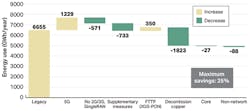Concern about energy efficiency is not new for telecom network operators. The difference today from years ago, however, is that energy efficiency is increasingly a board level concern. A simple reason for this is cost. Networks typically account for upwards of 90% of a telco’s energy consumption. If you consider that energy makes up between 5% and 6% of a telco’s operating expenditure, a hike in energy costs can deliver a sizeable hit to telecom companies’ profitability.
This short article is an adaptation of the report, “The Sustainable Telco: Engineering Networks for Net Zero”1. In it the TM Forum explores the fresh impetus for telcos to make their network operations more sustainable. Figure 1 sets the stage for the discussion.
The reality is that investors are increasingly threatening to withhold funds from telcos that lack a convincing long-term sustainability and energy efficiency plan. As a result, network operators are working with their suppliers and partners to find more efficient ways to process, store and transport data.
Their investments, which include the decommissioning of legacy networks, have been paying off. One source, MTN Consulting, reports an average 10% increase in network operator power use in 2021, even though the rise in data traffic has been much faster.
“We were able to gather the power consumption data for all of the cell sites and see some crazy anomalies,” says Michael Raj, Vice President of Network Enablement (AI & Data), Verizon. As a result, “we could question why this costs $1,000 versus the same configuration elsewhere, which only costs $500…”
The indication, then, is that CSPs are starting to mitigate the effects of a relentless rise in network traffic. Telefónica, for example, says it has managed to keep energy consumption stable despite data traffic increases of 45% in 2020 and 31% in 2021.
Thankfully, network operators are being helped by their wider digital transformation programs, some of which intertwine with sustainability projects. These initiatives could include AI’s use in automation; innovative machine learning; cross-enterprise approaches to collaboration; Open RAN development and network disaggregation. All are opening up new ways of thinking about operational and service models. As we will see in this article, they are having a positive effect on energy consumption.
The Realities
Globally, data transmission networks consumed in the range of 260-340 terawatt-hours (TWh) in 2021 as shown in Figure 1. This translates to 1.1%-1.4% of total global electricity use, according to estimates from the International Energy Agency (IEA). Interestingly, global data center electricity use in 2021 was 220-320 TWh, or around 0.9-1.3% of global electricity demand.
Both of these facts are relevant to operators around the world working to monetize their 5G networks. The holy grail, of course, is greater efficiency in the radio access network (RAN), which typically represents more than 75% of a service provider’s network power consumption, according to Ericsson. Additional data suggests the industry has made considerable progress and is starting to reap the benefits of more energy efficient design of 5G networks. A study by French telecoms regulator, ARCEP, shows that although deploying 5G networks alongside 4G infrastructure will incur an initial spike in energy consumption, it should result in a tenfold decrease between 2020 and 2028, compared to using only 4G networks.
A recent Analysys Mason report, “Driving down energy usage across telecoms networks: 5G RAN and beyond”, shows a best-case scenario for energy reduction in a country the size of the UK. (See Figure 2.) “Decommissioning copper is the biggest step that most operators can take to reduce their energy usage,” say the report authors. “Indeed, FTTP (fiber-to-the-premises) is much more energy efficient than copper. Moving to a 4G/5G Single RAN deployment that eliminates the need for a separate 2G/3G RAN also provides a significant direct reduction in energy use.”
Tactical Strategies
Although decommissioning is today’s silver bullet for long-established telcos, its benefits are finite. CSPs are therefore turning to additional measures, such as network automation, which will improve areas like fault detection and self-optimization of systems. They can also aid with the dynamic shutdown of unused network elements and the use of Open RAN, network sharing. All could help reduce power consumption and maintenance costs across the 5G network.
CSPs are also applying greater pressure on their suppliers to find new ways to make equipment more energy efficient, as well as developing their own solutions. Network suppliers are responding to the call and have already “shifted the focus of equipment improvement towards the green agenda,” says Gaurav Arora, Director, Sustainability & Operational Excellence, Telenor Group IHQ.
While AI and machine learning can also be leveraged to lower telcos environmental footprints, CSPs network sites and operations are complex. Therefore, a lot of work must go into cleaning and structuring diverse data streams before AI and machine learning systems can harness them. Thankfully, many operators are already making those intelligent management systems a reality.
Verizon’s Digital Twin Example
Verizon has developed a data analytics platform which provides a virtual representation, or digital twin, of its physical network to analyze and predict the performance, cost and efficiency of its network sites and equipment. Part of the company’s wider investment in predictive analytics, the digital twin provides important insights into how Verizon can save energy costs and work with suppliers to improve network efficiency and performance.
“We were able to gather the power consumption data for all of the cell sites and see some crazy anomalies,” says Michael Raj, Vice President of Network Enablement (AI & Data), at Verizon. As a result, “Verizon’s digital twin also allows the company to visualize and compare how different vendors’ equipment consumes energy in the field as opposed to in a lab. The company uses the results to push for better performance. “Let’s say for 100 gigabytes of capacity, vendor A proves to be 35% more efficient in practice than vendor B. That allows us to push vendor B to create a more energy efficient solution,” says Raj.
Verizon also shares that providing a standardized environment in which to visualize issues and test potential solutions in the form of a digital twin has encouraged teams to take a more creative approach to improving operations. “It’s allowed us to increase the ideation across our operations team now that they have a single source to look at how the standard differs across networks, lines of business, services and types of technology,” explains Raj.
Once the systems are in place, they can be their own best advocates. Verizon, for example, is now able to forecast energy costs based on factors such as the addition of a new cell site or decommissioning, as well as price fluctuations in energy markets. This gives financial officers a much more detailed energy price forecast against which to budget, which in turn helps them better manage expectations of financial markets.
RAN/ORAN Evolution
Because network functions increasingly operate as cloud-based software—whether through RAN virtualization, the development of Open RAN, or 5G standalone (5G SA) networks which have a cloud-native core—CSPs should be able to go further in using AI and machine learning to automatically collect, analyze and deploy data to improve energy efficiency.
The terms RAN virtualization and Open RAN can be used interchangeably, but their aims differ. Whereas RAN virtualization refers to implementing RAN functionality as software and running it on generic server hardware, Open RAN may well involve virtualization, but its principal aim is interoperability. CSPs are pushing Open RAN because they want to use standards-based, interoperable interfaces to interconnect disaggregated RAN elements, which makes it easier to build networks using a mix of suppliers. And the telcos behind Open RAN are also stressing its greener credentials.
The Open RAN Policy Coalition, with AT&T and Verizon among its members, also describes one of the benefits of Open RAN as being able to tap into the energy efficiencies of cloud computing: “Compared with the traditional RAN, Open RAN’s disaggregated, software-centric approach can accelerate the shift of compute resources to large data centers, leveraging advances in data center power optimization. By running as much software as possible in the cloud, Open RAN networks can take advantage of the economies of scale inherent to large data centers. Cloud data centers can leverage centralized cooling, lighting, and electricity purchasing agreements, bringing down power costs compared to local compute operations.”
The Long Road
Even if Open RAN delivers on its energy efficiency promise, it won’t happen any time soon. Rolling out an extensive Open RAN network is neither fast nor easy for CSPs with extensive networks using other technologies.
Vodafone, which is a strong Open RAN advocate, says it aims to have 30% of all its EU mobile sites using the technology by 2030. For other telcos, the speed of Open RAN adoption is likely to be slower. Nonetheless, Open RAN does point to telcos’ determination to harness a cloud-native, software-based approach to the RAN as a means to improve energy efficiency.
The good news is today’s progressive operators are coming up with inventive ways to reduce their footprints to become greener organizations. They will need to ramp up the pace if they are going to meet increasingly ambitious sustainability targets—or even, perhaps, to keep the mobile services we all rely on up and running without interruption.
REFERENCES AND NOTES
1. “The Sustainable Telco: Engineering Networks for Net Zero”, report by TM Forum, https://inform.tmforum.org/research-and-analysis/reports/the-sustainable-telco-engineering-networks-for-net-zero
For more information about the report, “The Sustainable Telco: Engineering Networks for Net Zero”, by TM Forum, please click this link: https://inform.tmforum.org/research-and-analysis/reports/the-sustainable-telco-engineering-networks-for-net-zero.
About the Author
Joanne Taaffe
Editor in Chief, Inform, TM Forum
Joanne Taaffe is Editor in Chief, Inform, TM Forum. She has more than 20 years of experience in covering the telecoms and IT sectors, including for Total Telecom Magazine and BT, and takes a keen interest in how scientific and technological advances can be put to practical use. For more information, visit https://inform.tmforum.org. Follow TM Forum on Twitter: @tmforumorg, Facebook: https://www.facebook.com/tmforum and LinkedIn: https://www.linkedin.com/company/tm-forum.



